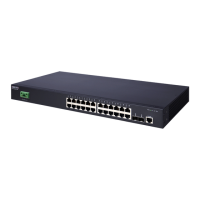Chapter 24
| Multicast Filtering Commands
IGMP Snooping
– 645 –
Example
The following shows how to configure the timeout to 400 seconds:
Console(config)#ip igmp snooping router-port-expire-time 400
Console(config)#
ip igmp snooping
tcn-flood
This command enables flooding of multicast traffic if a spanning tree topology
change notification (TCN) occurs. Use the no form to disable flooding.
Syntax
[no] ip igmp snooping tcn-flood
Default Setting
Disabled
Command Mode
Global Configuration
Command Usage
◆ When a spanning tree topology change occurs, the multicast membership
information learned by the switch may be out of date. For example, a host
linked to one port before the topology change (TC) may be moved to another
port after the change. To ensure that multicast data is delivered to all receivers,
by default, a switch in a VLAN (with IGMP snooping enabled) that receives a
Bridge Protocol Data Unit (BPDU) with the TC bit set (by the root bridge) will
enter into “multicast flooding mode” for a period of time until the topology has
stabilized and the new locations of all multicast receivers are learned.
◆ If a topology change notification (TCN) is received, and all the uplink ports are
subsequently deleted, a timeout mechanism is used to delete all of the
currently learned multicast channels.
◆ When a new uplink port starts up, the switch sends unsolicited reports for all
current learned channels out through the new uplink port.
◆ By default, the switch immediately enters into “multicast flooding mode” when
a spanning tree topology change occurs. In this mode, multicast traffic will be
flooded to all VLAN ports. If many ports have subscribed to different multicast
groups, flooding may cause excessive loading on the link between the switch
and the end host. Flooding may be disabled to avoid this, causing multicast
traffic to be delivered only to those ports on which multicast group members
have been learned.
◆ When the spanning tree topology changes, the root bridge sends a proxy
query to quickly re-learn the host membership/port relations for multicast
channels. The root bridge also sends an unsolicited Multicast Router Discover
(MRD) request to quickly locate the multicast routers in this VLAN.

